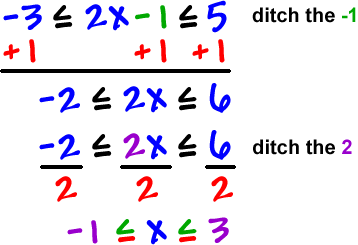So far, we've just been solving inequalities with two parts: a left side and a right side like this
![]()
But, sometimes we'll have inequalities with three parts:
![]()
Sometimes, these are called compound inequalities.
So, what do we do on these?
Our goal is the same:
Get the x alone! |
On these, we just get him alone in the middle section. So, just like before, pretend that there are really = signs and go about your business... We'll just be working all three sections at once.
Let's go:
![]()
Get the x alone in the middle...


![]()
But, what does this mean?
x can be -1... or x can be 3...or x can be a number between -1 and 3... like 0 or 2.315.